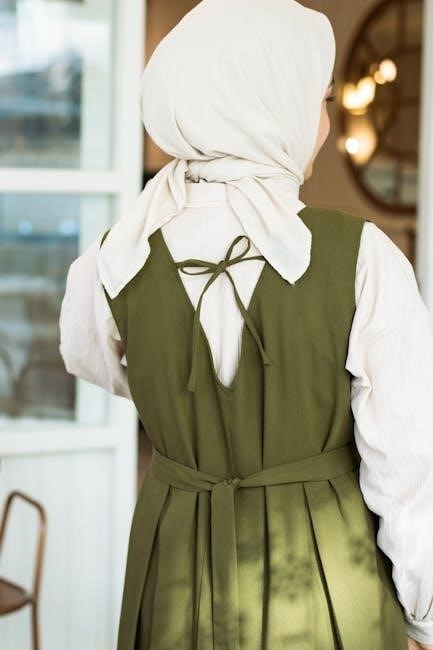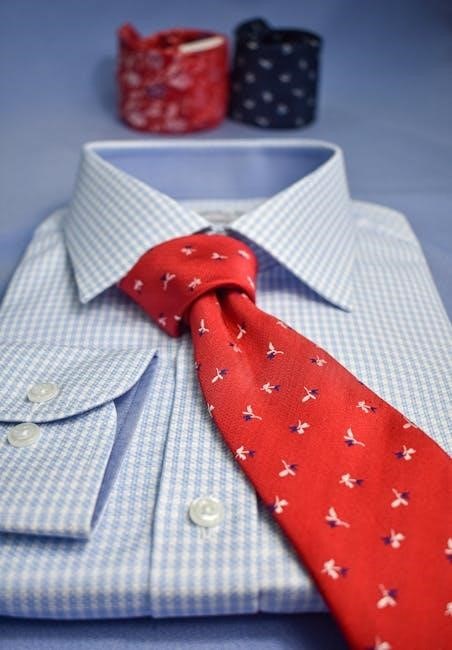Tie knots are essential for completing a polished outfit, offering versatility and style. Mastering various knots enhances professionalism and confidence, making them a must-learn skill for any occasion.
Importance of Knowing Different Tie Knots
Mastering different tie knots is crucial for versatility in styling and making a strong impression. Each knot has unique characteristics, making them suitable for various occasions and collar types. The Four-in-Hand knot, for instance, is simple and versatile, while the Windsor knot offers a bold, formal look. Knowing multiple knots allows you to adapt to different environments, from casual events to formal gatherings. It also enhances your professionalism and confidence, as the right knot can elevate your entire outfit. Different knots complement specific collar styles, ensuring a polished appearance. By learning various techniques, you can tailor your look to match the formality and aesthetic of any event, showcasing attention to detail and personal style.
Popular Tie Knots for Different Occasions
Choosing the right tie knot can elevate your outfit and suit the occasion perfectly. For casual events, the Four-in-Hand knot is a classic choice due to its simplicity and versatility. The Half Windsor knot strikes a balance between casual and formal, making it ideal for business meetings or semi-formal gatherings. The Windsor knot, with its wide triangular shape, is reserved for formal events like weddings or job interviews. Meanwhile, the Bow Tie knot is a staple for black-tie events and adds a touch of elegance. Each knot has its unique style and suits specific occasions, allowing you to tailor your look for maximum impact and appropriateness.
Four-in-Hand Knot
The Four-in-Hand Knot is the simplest and most versatile tie knot, perfect for casual occasions. Its ease of tying makes it a great choice for everyday wear.
Step-by-Step Guide to Tying a Four-in-Hand Knot
- Place the tie around your neck with the wide end on your right and the narrow end on your left, hanging down about 12 inches below the neck.
- Cross the wide end over the narrow end, forming an “X” shape in front.
- Loop the wide end behind the narrow end and bring it up through the neck loop from the right side.
- Bring the wide end down through the loop you just created in front.
- Gently pull the wide end to tighten the knot and adjust it to center it under your collar.
This knot is simple, versatile, and works well with most collar styles, making it perfect for everyday wear.
Best Collar Styles for the Four-in-Hand Knot
The Four-in-Hand Knot pairs best with point collars, button-down collars, and spread collars. Its slim, asymmetrical shape complements narrower collar styles, creating a balanced look. For a classic appearance, opt for a point collar, as it enhances the knot’s simplicity. Button-down collars add a subtle texture, while spread collars offer a slightly more formal touch. Avoid wide or cutaway collars, as they may overpower the knot’s understated design. This versatility makes the Four-in-Hand Knot suitable for both casual and formal occasions, ensuring a polished yet effortless style.

Half Windsor Knot
The Half Windsor Knot is a medium-sized, symmetrical tie knot, ideal for formal and casual events. It pairs well with point and spread collars, offering versatility and balance.

How to Tie a Half Windsor Knot
To tie a Half Windsor Knot, start by draping the tie around your neck with the wide end on your right and the narrow end on your left. Cross the wide end over the narrow end, then loop it behind and bring it up through the neck loop from the right side. Next, pass the wide end behind the narrow end and bring it up through the loop again from the left side. Tighten the knot gently to form a symmetrical triangular shape. Adjust the tie so it fits snugly under your collar. This knot is ideal for formal or business casual settings, offering a balanced and polished look.
Differences Between Full Windsor and Half Windsor Knots
The Full Windsor Knot and the Half Windsor Knot differ in size and formality. The Full Windsor creates a large, triangular knot, making it ideal for formal events like weddings or executive meetings. In contrast, the Half Windsor produces a medium-sized, symmetrical knot, suitable for both formal and business casual settings. The Full Windsor requires an extra loop during tying, adding bulk, while the Half Windsor is simpler and less bulky. Both knots work well with spread collars, but the Full Windsor is more statement-making, whereas the Half Windsor offers versatility for everyday wear. Choose based on the occasion and desired impact.

Windsor Knot
The Windsor Knot is a classic choice for formal events, creating a wide, triangular shape that makes a strong statement. It pairs perfectly with spread collars and formal attire.
Mastering the Windsor Knot
Mastering the Windsor Knot requires precision and practice, as it is a thicker, triangular knot ideal for formal events like weddings and business meetings. Begin by draping the tie around your neck with the wide end on your right. Cross the wide end over the narrow end, loop it behind, and bring it up through the neck loop. Pass the wide end behind the narrow end again, then up and through the loop once more. Tighten the knot gently to form a symmetrical shape. The Windsor Knot is best paired with spread-collar shirts and suits formal occasions perfectly, making it a timeless choice for confident professionalism.
When to Use the Windsor Knot
The Windsor Knot is ideal for formal events such as weddings, job interviews, and business meetings. Its thick, triangular shape makes it a bold choice, perfect for conveying confidence and professionalism. Pair it with spread-collar shirts, as the knot’s size complements the space between the collar points. Avoid using it with narrow or button-down collars, as it may appear too bulky. The Windsor Knot is also suitable for high-profile occasions like black-tie events or formal galas. Its versatility and striking appearance make it a go-to for situations requiring a polished, sophisticated look.

Bow Tie Knot
The bow tie knot is a classic choice for formal events like black-tie weddings and galas. It adds sophistication and elegance to any outfit, making it a must-know for special occasions.
Step-by-Step Guide to Tying a Bow Tie
To tie a bow tie, start by facing a mirror and placing the bow tie around your neck with the ends hanging evenly. Cross the right end over the left, forming an “X” shape. Loop the right end behind the left and bring it up through the center loop. Tighten gently by pulling the ends apart. Fold the left side into a bow shape and secure it by passing the right end behind it. Bring the right end up through the loop and tighten the bow by adjusting both sides. Ensure the bow is centered and the wings are symmetrical for a polished look.
Choosing the Right Bow Tie for Formal Events
Selecting the appropriate bow tie for formal events is crucial for completing your outfit. For black-tie events, opt for a black bow tie to match the formality of the occasion. White-tie events may require a white bow tie, paired with a detachable collar shirt. Consider fabric and texture, as silk or satin bow ties are ideal for formal settings. Patterns like dots or stripes can add personality but should complement your shirt and suit; Ensure the bow tie matches your face shape—wider faces suit larger bows, while narrower faces look better with slimmer styles. Properly coordinating your bow tie with the event’s dress code ensures a polished and sophisticated appearance.
Tie Knots for Specific Occasions
Tie knots are chosen based on the occasion, with Windsor and Bow Tie knots for formal events, and Four-in-Hand and Half Windsor for casual settings, ensuring a balance between style and appropriateness.
Formal Events: Windsor and Bow Tie Knots
For formal events, the Windsor and Bow Tie knots are ideal choices. The Windsor knot, with its wide triangular shape, is perfect for spread collars and high-formality settings like weddings or business meetings. The Bow Tie knot, on the other hand, is quintessential for black-tie events, adding a touch of elegance and sophistication. Both knots are versatile and complement formal attire, ensuring a polished and professional appearance. Whether attending a gala, a wedding, or a corporate event, these knots are essential for making a refined statement.
Casual Events: Four-in-Hand and Half Windsor Knots
The Four-in-Hand and Half Windsor knots are excellent choices for casual events. The Four-in-Hand knot is simple, versatile, and ideal for everyday wear, pairing well with point or button-down collars. Its smaller, slightly asymmetrical shape makes it perfect for less formal settings, such as office meetings or social gatherings. The Half Windsor knot offers a slightly larger, more symmetrical option while still maintaining a casual vibe. Both knots are easy to master and work seamlessly with narrower collars, making them great for creating a relaxed yet polished look. They are versatile enough to suit a variety of casual occasions, ensuring a stylish and put-together appearance.

Tips for Mastering Tie Knots
Mastering tie knots requires patience and practice. Avoid common mistakes by following step-by-step guides and ensuring the knot fits perfectly. Consistent practice leads to mastery.
Common Mistakes to Avoid
When learning tie knots, common mistakes include over-tightening the knot, creating uneven loops, or not adjusting the tie properly. Ensure the wide end is correctly positioned and avoid excessive tugging, which can distort the shape. Practice in front of a mirror to maintain symmetry and proportion. Additionally, choosing the wrong knot size for your collar style can lead to a sloppy appearance. Start with basic knots like the Four-in-Hand or Half Windsor before progressing to more complex styles. Patience and consistent practice are key to mastering tie knots without frustration. Following step-by-step guides and videos can also help minimize errors and improve technique.
How to Adjust the Knot for a Perfect Fit
To ensure your tie knot fits perfectly, start by positioning the wide end on your right and the narrow end on your left, with the narrow end reaching just above your belly button. After tying the knot, gently pull it up to center it under your collar. Adjust the knot by tugging the wide end downward to tighten or the narrow end upward to loosen, ensuring symmetry. Avoid over-tightening, as this can create a bulky appearance. Once the knot is secure, tuck the narrow end into your shirt and smooth the tie to achieve a polished look. Minor adjustments to the knot’s alignment and tightness will ensure a flawless fit.

Tie Width and Knot Size
Choosing the right tie width ensures balance with your collar and knot size. A wider tie complements larger knots like the Windsor, while narrower ties suit smaller knots like the Four-in-Hand, enhancing your overall appearance.
Choosing the Right Tie Width for Your Knot
Selecting the appropriate tie width is crucial for achieving a balanced look. A wider tie pairs well with larger knots like the Windsor, creating a bold, symmetrical appearance. Narrower ties, on the other hand, complement smaller knots such as the Four-in-Hand, ensuring a sleek, streamlined look. The tie width should also align with your collar style—wider ties suit spread collars, while narrower ties work best with point or button-down collars. Additionally, consider your body type; slimmer individuals may prefer narrower ties to avoid bulkiness, while broader frames can opt for wider ties to create harmony. Balancing tie width with knot size enhances your overall aesthetic.
How Knot Size Affects Your Overall Look
Knot size plays a significant role in shaping your appearance. A larger knot, such as the Windsor, creates a bold, statement-making look, ideal for formal events and broader frames. Conversely, smaller knots like the Four-in-Hand offer a subtle, casual vibe, perfect for slimmer builds or everyday wear. The size should complement your collar style and tie width to maintain balance. For example, a medium-sized Half Windsor knot strikes a versatile balance, working well for both formal and casual settings. Ensuring your knot size aligns with your outfit and body type is key to achieving a polished, cohesive look. Proper proportions enhance confidence and sophistication.
Mastering tie knots enhances confidence and versatility, ensuring a polished look for any occasion. Practice and experimentation with different styles will refine your skill and personal flair.
Final Thoughts on Mastering Tie Knots
Mastering tie knots is a journey that combines patience, practice, and personal style. Starting with simple knots like the Four-in-Hand and gradually moving to more complex styles like the Windsor or Bow Tie ensures a strong foundation. Consistency is key, as even the most intricate knots become second nature with repetition. Understanding the occasion and pairing the right knot with your outfit elevates your appearance and confidence. Remember, the perfect knot is not just about technique but also about proportions, ensuring your tie width complements your body type. With dedication, you’ll master the art of tie knots, enhancing your wardrobe and making a lasting impression.
Encouragement to Practice and Experiment
Practice is the cornerstone of mastering tie knots. Start with simple styles like the Four-in-Hand and gradually experiment with more complex knots like the Half Windsor or Bow Tie. Each attempt brings improvement, so don’t be discouraged by initial challenges. Experiment with different knots, collar styles, and tie widths to discover what suits you best. The key to confidence is consistency—spend a few minutes daily refining your technique. As you explore, you’ll find the perfect balance between formality and personal style. Remember, tie knots are not just functional but also a reflection of your personality. Keep practicing, and soon you’ll tie knots with ease and flair, elevating your look for every occasion.